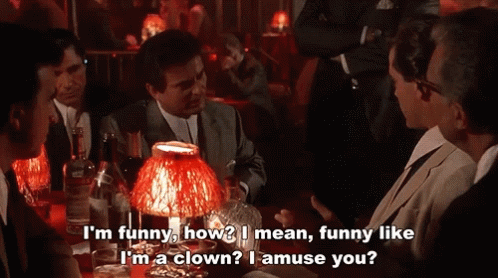Goodfellas is Scorsese’s rendition of the pinnacle Mafia movie genre popularized by The Godfather. Goodfellas is based on the real life story of Henry Hill, an Italian-Irish American, who after idolizing the mobsters from his street, eventually joins them. At the end, Henry “redeems” himself by eventually spilling the beans on his mafia’s escapades. His partners Tommy DeVito & Jimmy Conway- pictured above- are a pure Italian and Irish-Italian mix respectively, and the three work their way up the Mafia chain. But what separates Goodfellas from the other mob movies trying to emulate The Godfather‘s success? Well, it’s none other than the director himself: Scorsese.
Scorsese characterizes Henry as a generic middle-level mob member, listening to orders, getting favors, and eventually being the key informant to the whole process. His creation of Tommy DeVito, however, makes the movie so memorable. Tommy is a much more psychotic- and funny- character than Henry, and he kills a high-rank mobster for “busting his balls.” This is the act that gets Tommy “whacked” near the end, despite Tommy’s continual climb through the rankings. Jimmy Conway is a sort of mediator between the two, helping them receive jobs and get paid, while Henry and Tommy do the dirty work. The trio creates a chaotic yet memorable squad that we follow throughout the film.

Tommy "busting the balls" of another mobster.
Scorsese’s greatest hit, Taxi Driver (which I will probably cover some other time), features a similar character-driven story delving into the darkness of the “real” world. Unlike both The Godfather and Taxi Driver, Goodfellas adds a lot of comedic elements, making it enjoyable for both film lovers and a general populace alike. We see these comedic elements return for Scorsese’s The Wolf of Wallstreet. This variety and cinema knowledge is what makes Scorsese such a great director.
Henry Hill, as mentioned above, ends up ratting on the entire Mafia squad at the end of the movie. What makes Scorsese’s vision of Henry Hill so genuine, however, is that he never truly “redeems” himself. He may have got his mafia family “ball-busted,” but his motives never truly changed. Throughout the film and through his monologues, Henry mentions his material desire of fancy cars, pretty women, etc. After Tommy’s death, Henry realizes that the mob would eventually come for him. In the end, Henry’s confession is simply to save his own balls from being busted themselves.
What makes this one of my favorite movies of all time, other than the comedy, is Tommy. Tommy is undoubtedly psychotic, but without Scorsese’s vision of him, the movie would lose so much of its chaotic elements, which morphs a run-of-the-mill crime drama into Scorsese’s masterpiece.
Great work! I can tell you have a deep understanding of Scorsese. I’ve watched the Wolf of Wall Street and it’s a great movie. One piece of improvement would be to include more of your personal opinion.
Interesting! You really went into depth in providing the reader with a solid understanding of Scorsese. Someone who hasn’t even watched the movie would be able to pick out the details after reading your blurb. However, most of this post sounds like you are simply restating the events and plot line that occurred in the movie. I agree with Rohan in the sense that you should inject more commentary and your own personal thoughts into this for the future. But for now, good work!